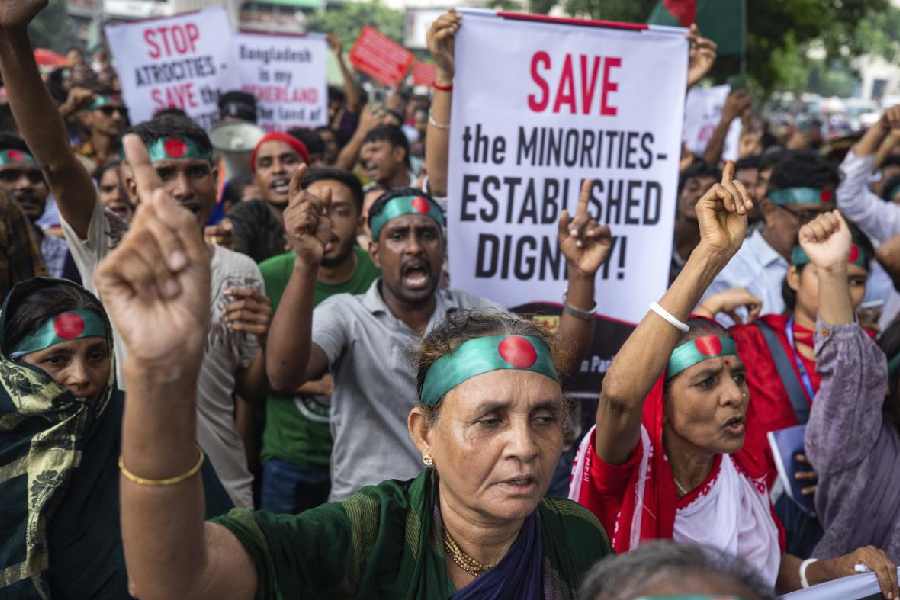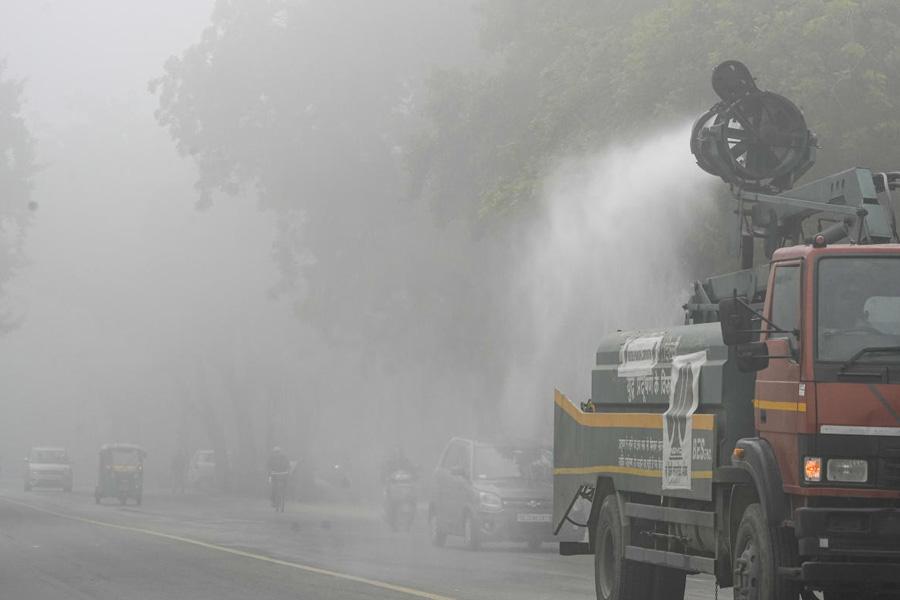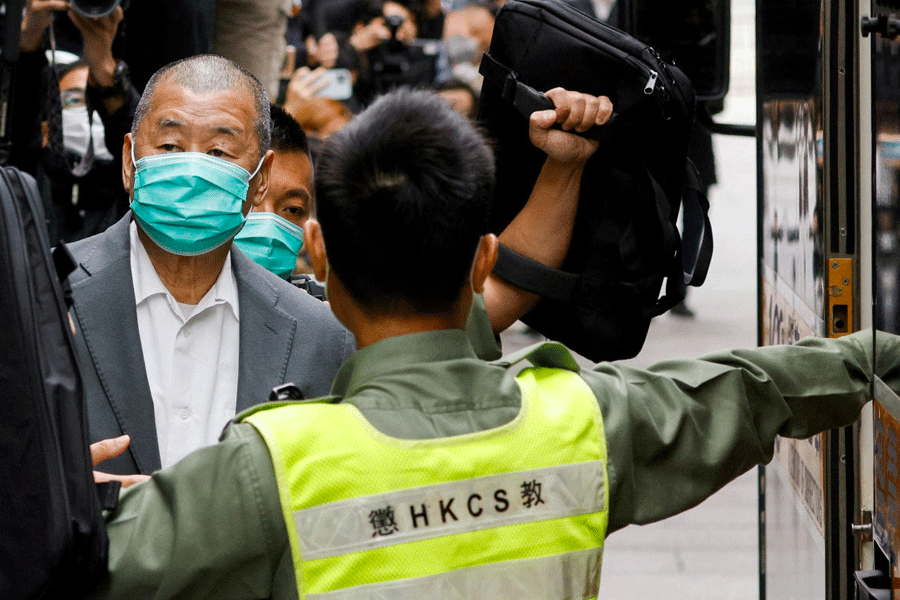What causes more concern about current goings-on in Bangladesh than in Pakistan is the likely impact on India. Pakistan has always been the villain of popular Indian culture but local variants of the “Carthago delenda est, Carthage must be destroyed” rhetoric, with which Cato the Elder, the ancient Roman politician, ended his thundering speeches, don’t draw much distinction now between the two Muslim neighbours.
Despite Muhammad Yunus’s posturing in China, however, Bangladesh’s capacity to injure India is limited. But it can hurt India by acting irresponsibly against the rapidly dwindling Hindu community there and through the Yunus regime’s actions against local elements that are well disposed towards this country. In either case, some form of direct or indirect reprisal might be expected if persecution crosses a limit. It would be especially unfortunate if this means alienated Indians wreaking vengeance on India’s own innocent minority.
There’s enough evidence on both sides to bear out almost any theory one cares to advance about the subcontinent’s Hindus and Muslims. Donald Trump claims with more emotion than information that they have been at loggerheads for a thousand years. Much longer, insists Pakistan’s army chief, General Syed Asim Munir Ahmed Shah, trotting out all the reasons for estrangement between Jew and Gentile that Shakespeare’s Shylock might have given. “Two cats in a bag scratching and snarling at each other” was a westernised West Punjabi’s explanation for Partition. Historians and social scientists are not alone in adducing the grim evidence of cyclical killings in Calcutta, Noakhali and Bihar that were seared into India’s blistered and bleeding consciousness in the 1940s and the 1950s. East Bengal’s economic rationale of Muslims (mainly working class) resenting Hindus (landlords and middle-class professionals) underscored by notions of caste, class and touchability is seldom mentioned.
Traces of that bitter memory are still laced into Bengali conversation and can be detected the moment the speaker drops his guard. Adolescent motorcyclists crammed on a bike without a single helmet among them prompt references to known Muslim areas of Calcutta. When a guest at a rare inter-religion marriage asked if the groom was Bengali, another guest cut in with “No, Muslim!” Overhearing, the groom lost no time in confirming, “Quite right. We’re Arab.” Another guest — as it happens, a veteran Muslim — muttered that the alternative was of a Hindu “untouchable” convert to Islam.
One of the last deputy high commissioners that Islamabad defiantly posted in Calcutta after East Pakistan became Bangladesh seldom lost a chance to list details of every communal conflagration to erupt in India after 1947. He claimed that in contrast Islamic Pakistan was an oasis of religious peace and tranquility. “Naturally” was one wry response. “They’ve massacred or driven out all their Hindus.” And so it went on. The talk may have shifted to a higher material plane in North and western India. There may not be any remembered rancour in the South. But sly asides give away the burden of history (and the pain of suffered experience) in the East where the 1950 Nehru-Liaquat Ali Pact is blamed for facilitating the very abuses it was supposed to prevent.
Ostensibly enacted to address the plight of refugees, protect religious minorities, and improve relations between the two nations, the Pact was blamed for giving an impetus to eviction, preventing refugees from returning to their original homes, and thwarting the return of abducted women and the restoration of looted property. Instead, it was said to encourage coerced conversions and expose East Bengal's Hindus to even more pressure. Discrimination in the India to which refugees fled often transformed destitution into permanency, as Pranab Mukherjee elaborated in a note that pointed out discrepancies in New Delhi’s treatment of refugees from east and west. Special projects like Delhi’s Khan Market or the acquisition and redistribution of evacuee property made all the difference; there was a yawning gap in per capita expenditure on the dispossessed from East and West Pakistan.
The possible (it can’t be assumed to be actual) hostility of India’s own Muslims may be an irritant, especially if it is aggressively flaunted through attire and appearance. What matters more is what Jawaharlal Nehru told the All-India Congress Committee in May 1958. Taking his cue from the French philosopher, Jean-Paul Sartre, Nehru warned that the “communalism of the majority is far more dangerous than the communalism of the minority.” He may have had in mind the Carthago delenda est passions that swept away North Africa’s Carthaginian civilisation in 146 BC, not to be rebuilt for a century, when he added that such force often “wears the garb of nationalism". It being deemed unpatriotic for loyal Indians to be secular, a demagogue like Cato could be viewed as the apostle of the Hindutva of the times, projecting the enemy’s destruction
as a sacred national duty like Operation Sindoor.
Never insensitive to the frailties of the national character, Nehru should have anticipated these compulsions. As he boldly admitted, “We have thus communalism ingrained in us and it comes out quickly at the slightest provocation and even decent people begin to behave like barbarians when this communalism is aroused in them.” In evidence, I was told of an episode during one of North Calcutta’s periodic blood-lettings: apparently, an elderly Bengali bhadralok who was about to strike a Muslim child with a stout bamboo justified the contemplated brutality with two Bengali words signifying that a cobra’s hatchling was as dangerous as a cobra. I also recall the consternation in 1964 over unconfirmed tales of railway compartments packed with corpses from across the eastern border. Fearing a deadly backlash among Bihari factory workers along the Hooghly, the authorities imposed tight control on newspapers, including the one I worked for.
Today, one hears Bangladeshis in Britain explaining the flight of the Hindu millions in terms of jealousy and a refusal to accept the strides that the formerly downtrodden East Bengal Muslim peasant had taken both under Pakistani rule and after India’s 1971 military victory liberated Bangladesh. It cannot be again said that although the rise of Bangladesh as a nation may have decimated the local Hindu community, the emergence of a Bangladeshi middle class with internationalist and even aristocratic pretensions represents something of an unparalleled sociological revolution. A Bangladeshi in Singapore even likened his native country to India’s Jammu and Kashmir problem, claiming that India had conceded a people’s right to make a second choice just once and that, too, only because an independent Bangladesh suited New Delhi’s own strategic designs. That experiment would never be repeated.
What it boils down to is that secularism, as interpreted and propagated by Nehru, may still be regarded as an ideal personal faith but has failed absolutely as a political ideology. My friend, Jolly Mohan Kaul, who died in 2020 a year short of a century, used to say that while Nehruvian secularism could never succeed in India, the socialism that Mahatma Gandhi preached would. It did not disrespect religion. It even co-opted religion, especially Hinduism, just as his wife, the formidable Manikuntala Sen, had done by receiving diksha from a Hindu swami. I can’t remember if Jolly, too, was formally initiated but he was a devout Gandhian for the last three decades of his life without spurning the communism of his teenage years.
There may be something to commend such eclecticism but it will not be allowed to shape the future under the Bharatiya Janata Party and its assortment of rampaging organisations. The retaliation that Bangladeshi cussedness is bound to invite holds the threat of an orgy of destructiveness that its authors will no doubt try to justify by citing the logic of numbers.










